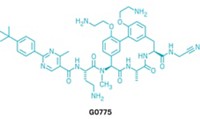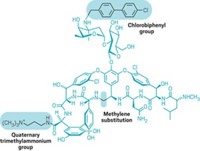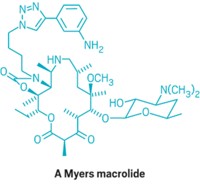Advertisement
Grab your lab coat. Let's get started
Welcome!
Welcome!
Create an account below to get 6 C&EN articles per month, receive newsletters and more - all free.
It seems this is your first time logging in online. Please enter the following information to continue.
As an ACS member you automatically get access to this site. All we need is few more details to create your reading experience.
Not you? Sign in with a different account.
Not you? Sign in with a different account.
ERROR 1
ERROR 1
ERROR 2
ERROR 2
ERROR 2
ERROR 2
ERROR 2
Password and Confirm password must match.
If you have an ACS member number, please enter it here so we can link this account to your membership. (optional)
ERROR 2
ACS values your privacy. By submitting your information, you are gaining access to C&EN and subscribing to our weekly newsletter. We use the information you provide to make your reading experience better, and we will never sell your data to third party members.
Antibiotics
How to outwit antibiotic resistance with chemical know-how
Guided by protein structure, chemists build group A streptogramins that evade deactivating enzyme
by Bethany Halford
September 24, 2020
| A version of this story appeared in
Volume 98, Issue 37
Using structural biology and synthetic chemistry, scientists are bolstering the armament of streptogramin antibiotics. This class of bacteria fighters has largely been abandoned, in part because of problems with resistance. They hope their interdisciplinary approach will guide others in search of new antibiotics.
Synercid, which was approved by the US Food and Drug administration in 1999, is the only streptogramin antibiotic on the market in the US. These antibiotics combine two different types of molecules, known as group A and group B streptogramins, to fight Staphylococcus aureus and Enterococcus faecium infections. Group A streptogramins can mount a defense, albeit a weak one, without the help of group B. But if bacteria develop resistance to group A, group B often becomes ineffective.
“We think streptogramins haven’t reached their potential,” says Ian B. Seiple, a chemist at the University of California, San Francisco, who spearheaded the research. There are many things left to try. Seiple points out that chemical modifications to the group A streptogramin scaffold—a 23-membered macrocycle—have only been made in a few locations.
Seiple’s group previously developed a short, modular approach to naturally occurring group A streptogramins, such as virginiamycin M2 (J. Am. Chem. Soc. 2017, DOI: 10.1021/jacs.7b08577). By modifying the seven building blocks in this synthesis, the chemists were able to vastly expand the chemistry of group A streptogramin analogs.
The chemists then teamed up with UCSF structural biologist James S. Fraser’s lab to probe how these analogs bind to their ribosomal target and how they bind to virginiamycin acetyltransferase. This enzyme deactivates group A streptogramins by attaching an acetyl group to a key alcohol group. The team discovered a way to block this counterattack. They found a sweet spot on the antibiotic’s macrocyclic framework to introduce an allyl substituent that would prevent the deactivating enzyme from binding the group A streptogramin, without disrupting the antibiotic’s ability to bind to the bacterial ribosome. An analog with this substitution (shown) was able to stop S. aureus from growing in a test tubes and effectively fought an S. aureus infection in mice (Nature 2020, DOI: 10.1038/s41586-020-2761-3).
“This is a significant contribution to the development of group A streptogramin antibiotics,” says James S. Panek, a chemist at Boston University who has worked on streptogramins. The work, he says, “underscores the pivotal role that chemical synthesis plays in the design and development of potentially useful and novel antibiotics.”
Seiple says the group will keep optimizing the antibiotic analogs. “None of the compounds from this paper are ready to go into humans or even further animal studies,” he notes. But he hopes their work’s example how a synergy of microbiology, structural biology, and synthetic chemistry can overcome a longstanding resistance mechanism will inspire people to do the same with other antibiotics.





Join the conversation
Contact the reporter
Submit a Letter to the Editor for publication
Engage with us on Twitter